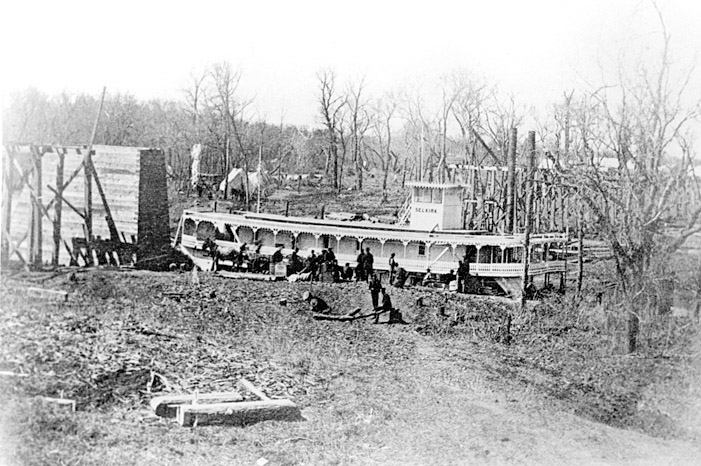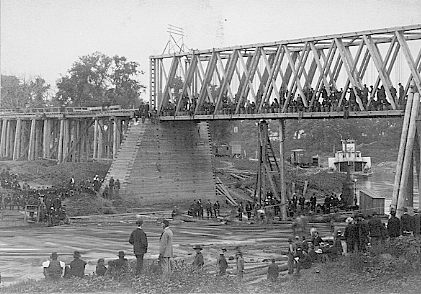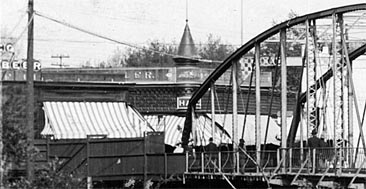Northern Pacific Railroad Bridge
 Image courtesy of the Clay County Historical Society
Image courtesy of the Clay County Historical Society
Fargo came into being because the Northern Pacific Railroad built a bridge across the Red River. The bridge was started in the early winter of 1871 and was completed in June of 1872. The photograph above was obviously taken between those dates while the bridge was being built. Note the steamship Selkirk built in 1871. The photograph looks southwest from Minnesota toward Fargo. The tents on the Dakota side may have been part of "Fargo in the Timber."

The bridge was started in the early winter of 1871. The bridge was completed in June of 1872 and the first engine, bedecked in flowers, entered Fargo.
The image to the right is a photograph by O. E. Flaten, a Moorhead photographer who worked from 1879 to to 1929. It appears that this was taken at some sort of ceremony at the bridge. Note that the footbridge seen on the lower image has not yet been built. Note also the steamboat. I believe that the picture is facing north from the Moorhead side of the river.
 Northern Pacific Railroad Bridge over the Red River (1871-1883)
Northern Pacific Railroad Bridge over the Red River (1871-1883)
The image above is one-half of a stereoview photograph (enlarged and cropped). The picture shows the first bridge across the Red River at Fargo/Moorhead. The bridge built was replaced in 1883, 1897, and in 1927.
Note the footbridge across the river just below the railroad bridge. I believe that we are looking north, hence the houses in the background are in Moorhead.
In February of 1872, the Northern Pacific Railroad filed a railroad plat of its road through Dakota Territory. The original townsite of Fargo was platted out of Section Seven and filed for record in the Cass County Deeds Office in January 1874. Island Park was a part of Section Seven and was deeded to the city for a park.
The Northern Pacific Railroad continued westward, reaching Bismarck in 1873. The NP railroad went bankrupt that year in Wall Street's Panic of 1873. Aggressive westward building restarted in 1879 under new ownership.
 NP Avenue Bridge over the Red River (1909)
NP Avenue Bridge over the Red River (1909)
The original 1872 bridge was replaced in 1883, 1897, and in 1927. The photographic postcard to the upper right is from 1909 and shows the third bridge. The writer of the postcard notes on the back that "the buildings you see are all saloons." (See enlarged view below.) Moorhead at that time was "wet" while Fargo was "dry." The writer also notes that "there is good fishing in the Red River."

